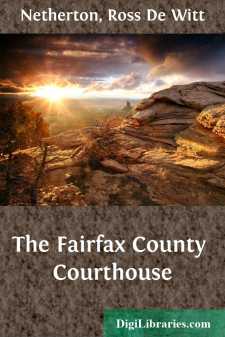Categories
- Antiques & Collectibles 13
- Architecture 36
- Art 48
- Bibles 22
- Biography & Autobiography 813
- Body, Mind & Spirit 142
- Business & Economics 28
- Children's Books 17
- Children's Fiction 14
- Computers 4
- Cooking 94
- Crafts & Hobbies 4
- Drama 346
- Education 46
- Family & Relationships 57
- Fiction 11829
- Games 19
- Gardening 17
- Health & Fitness 34
- History 1377
- House & Home 1
- Humor 147
- Juvenile Fiction 1873
- Juvenile Nonfiction 202
- Language Arts & Disciplines 88
- Law 16
- Literary Collections 686
- Literary Criticism 179
- Mathematics 13
- Medical 41
- Music 40
- Nature 179
- Non-Classifiable 1768
- Performing Arts 7
- Periodicals 1453
- Philosophy 64
- Photography 2
- Poetry 896
- Political Science 203
- Psychology 42
- Reference 154
- Religion 513
- Science 126
- Self-Help 84
- Social Science 81
- Sports & Recreation 34
- Study Aids 3
- Technology & Engineering 59
- Transportation 23
- Travel 463
- True Crime 29
The Fairfax County Courthouse
Categories:
Description:
Excerpt
ACKNOWLEDGMENTS
This monograph is one of a series of research reports on the historical and architectural landmarks of Fairfax County, Virginia. It has been prepared under the supervision of the Fairfax County Office of Comprehensive Planning, in cooperation with the Fairfax County History Commission, pursuant to a resolution of the Board of County Supervisors calling for a survey of the County's historic sites and buildings.
The authors of this report wish to acknowledge with thanks the assistance of Lindsey Carne, Mrs. J. H. Elliott, Lee Hubbard, Mrs. Jean Johnson Rust, and Mrs. Barry Sullivan, who provided information and graphics for this publication. Also valuable were the comments of the Honorable James Keith, Circuit Court Judge; Mrs. Edith M. Sprouse; John K. Gott; Mrs. Catharine Ratiner; and Mayo S. Stuntz, all of whom reviewed the manuscript with care prior to its final revisions.
Special thanks are tendered to the Honorable Thomas P. Chapman, Jr. and the Honorable W. Franklin Gooding, former Clerks of the Courts of Fairfax County; the Honorable James Hoofnagle, present Clerk of the Courts; and to Walter M. Macomber, architect of the 1967 reconstruction of the original wing of the courthouse, who granted extensive interviews which filled many of the gaps created by lack of documentary sources.
Throughout the entire research and writing of this report, the authors received valuable guidance and comments from the members of the Fairfax County History Commission and assistance from the staffs of the Fairfax County Public Library and the Virginia State Library.
Finally, the authors acknowledge with thanks the help of Jay Linard, Mrs. Verna McFeaters, Ms. Virginia Inge, Ms. Irene Rouse, Ms. Annette Thomas, and Ms. Robin Pedlar in manuscript preparation.
Ross Netherton
Ruby Waldeck
The Fairfax County Courthouse is an important addition to the historical record of Fairfax County, Virginia. It brings together in one volume a history of the Fairfax County Courthouses and a manual of the organization and operation of governmental affairs centered within them over the years. A particular insight with regard to the early years of the county is evident.
Dr. Netherton and Mrs. Waldeck describe the consequential role the courthouse enjoyed as a social center as they examine the governmental role which made it the centerpiece of Fairfax County. The reader will note that the early Fairfax County officials gained an understanding of the importance of democratic government in our nation through their participation in county government while the people they served developed a sense of community through their interaction at the courthouse. The present courthouse stands as a monument to the governmental and social prosperity Fairfax County has enjoyed.
This text documents the story of the building which has stood at the center of almost two centuries of political life in Fairfax County. The extensive footnotes will prove an invaluable aid to scholars exploring the history of the county. History students in our county's schools will find The Fairfax County Courthouse an important addition to their reading lists. We are all indebted to Ross Netherton and Ruby Waldeck for their contribution in casting such a revealing light upon the roots of Fairfax County, her people and government.
James E. Hoofnagle
Clerk of the Fairfax County Court
INTRODUCTION
Each generation of Americans has acknowledged its debt to Virginia's leaders whose skill in politics was demonstrated so well in a half-century that saw independence achieved and a new republic established. They were products of a system of government which itself had been perfected over more than 150 years before the colonies declared their independence. To these men—George Washington, George Mason, Thomas Jefferson, Patrick Henry, John Marshall, George Wythe, James Madison, and the Carters—the County court was an academy for education in the art of government. Important as it was to sit in the House of Burgesses at Williamsburg, the lessons of politics and public administration were learned best in the work of carrying on the government of a county. Virginia counties were unique in colonial history, for the considerable degree of autonomy enjoyed by the County courts gave them both a taste of responsibility for a wide range of public affairs and a measure of insulation from the changes of political fortune which determined events in Williamsburg, and later Richmond.
In Virginia, the county courthouse was the focal point of public affairs. Usually built in a central location, with more regard for accessibility from all corners of the county than for proximity to established centers of commerce, the courthouse came to be a unique complex of buildings related to the work of the court....


